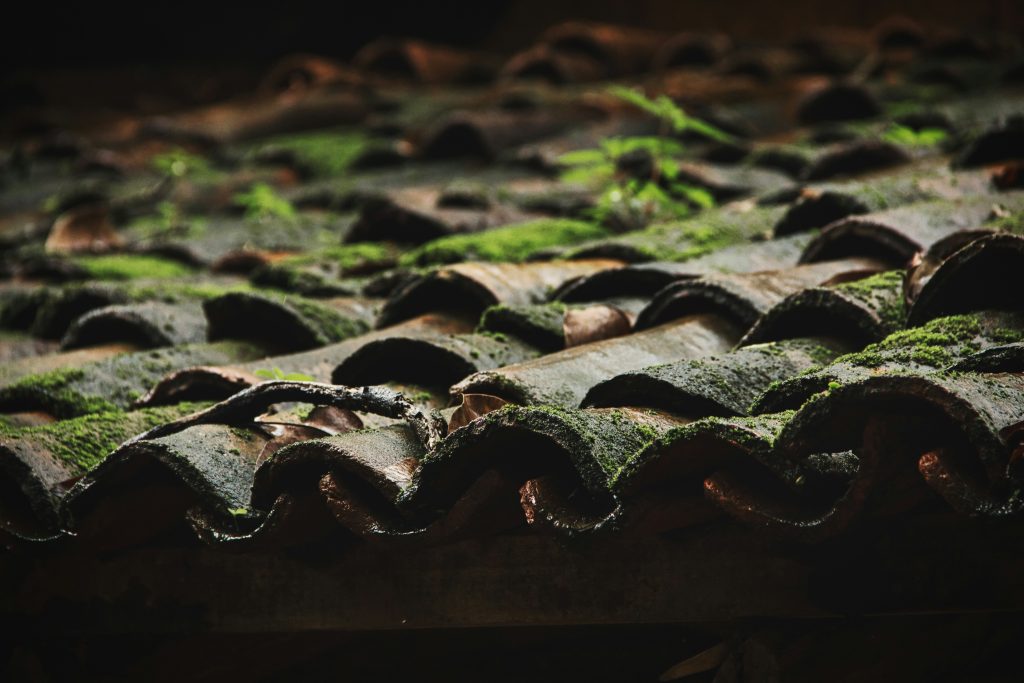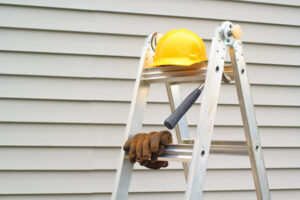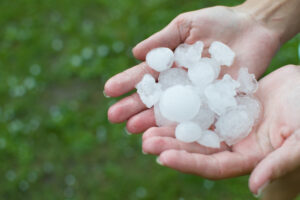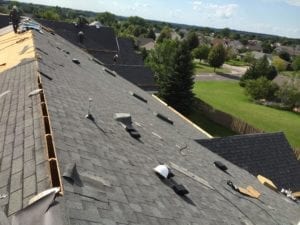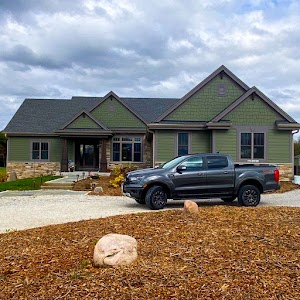To maintain clean roof shingles effectively, mix water and vinegar in a spray bottle. Apply the solution and let it sit before rinsing with a hose. This eco-friendly method removes dirt and grime without harsh chemicals. If you want to explore more ways to uphold clean shingles, there are different methods and products available. Regular upkeep will guarantee your roof stays in top condition and prevents future damage.
Importance of Roof Shingle Maintenance
Taking care of your roof shingles is essential to prolonging their lifespan.
Algae and moss can damage your shingles if not addressed promptly.
Don’t fall for common myths about roof shingle cleaning; proper maintenance is key to keeping your roof in top condition.
Algae and Moss Impact on Roof Shingles
Algae and moss can greatly affect the lifespan and appearance of your roof shingles, highlighting the importance of regular maintenance. When left unchecked, these organisms can lead to moisture retention, which may cause shingles to deteriorate faster.
Algae create dark streaks on the roof, impacting its curb appeal and potentially lowering your property’s value. Moss, on the other hand, tends to hold moisture against the shingles, accelerating their wear and tear. Additionally, the presence of algae and moss can make your roof more prone to leaks and other structural damage over time.
Common Myths About Roof Shingle Cleaning
To maintain the longevity and appearance of your roof shingles, it’s important to debunk common myths associated with roof shingle cleaning and emphasize the significance of regular maintenance practices.
Here are some common myths about roof shingle cleaning that you should be aware of:
- Myth 1: Power washing is the best way to clean roof shingles.
- Myth 2: Roof shingle cleaning is purely for aesthetic purposes.
- Myth 3: It’s unnecessary to clean roof shingles if there are no visible stains.
- Myth 4: Cleaning roof shingles is a one-time task that doesn’t require regular upkeep.
Different Methods for Cleaning Roof Shingles
When it comes to cleaning roof shingles, you have various options to choose from. Consider eco-friendly alternatives instead of harsh chemicals for a more sustainable approach.
You can also explore using simple home remedies to effectively tackle mildew on your roof shingles.
Eco-Friendly Alternatives to Chemical Roof Cleaning
Consider adopting eco-friendly alternatives when cleaning roof shingles to minimize environmental impact and promote sustainability. Here are some options to contemplate:
- Water and Vinegar Solution: A mixture of water and vinegar can help remove dirt and grime from your roof.
- Biodegradable Roof Cleaners: Look for cleaners that are labeled as biodegradable to guarantee they’re environmentally friendly.
- Pressure Washing with Plain Water: High-pressure water can be effective in cleaning roof shingles without the need for chemicals.
- Homemade Soap Solution: Mixing mild soap with water can be a gentle yet efficient way to clean your roof.
Using Home Remedies for Cleaning Mildew on Roof Shingles
Use household items like vinegar, baking soda, or lemon juice to tackle mildew on your roof shingles effectively.
Mix equal parts of water and vinegar in a spray bottle and apply it directly to the affected areas. Let it sit for about 30 minutes before scrubbing the mildew off with a brush.
Alternatively, create a paste using baking soda and water, apply it to the mildew spots, scrub gently, and rinse with water.
For a citrusy solution, squeeze fresh lemon juice onto the mildew, let it sit for 15-20 minutes, then scrub and rinse.
These natural remedies are gentle on your shingles while effectively combating mildew, leaving your roof clean and mold-free.
Choosing the Right Cleaning Products for Roof Shingles
When cleaning roof shingles, it’s important to choose the right products for the job.
You should consider the recommended cleaning frequency based on your roof type and learn how to safely dispose of any roof cleaning chemicals used.
Taking these factors into account will help you maintain the longevity and appearance of your roof.
Recommended Cleaning Frequency for Different Roof Types
To maintain the longevity and appearance of your roof, it’s essential to adhere to the recommended cleaning frequency tailored to different roof types and select the appropriate cleaning products for your roof shingles.
Here are some guidelines to help you determine how often you should clean your roof based on its material:
- Asphalt shingles: Clean every 1-3 years.
- Wood shingles: Clean every 3-5 years.
- Metal roofs: Clean every 2-5 years.
- Tile roofs: Clean every 2-3 years.
How to Dispose of Roof Cleaning Chemicals Safely
Safely dispose of roof cleaning chemicals by researching local regulations and utilizing designated waste disposal facilities. When choosing cleaning products for your roof shingles, opt for environmentally friendly options. Look for biodegradable solutions that are safe for plants, animals, and the surrounding ecosystem. Avoid harsh chemicals that can harm the environment and potentially damage your roof over time.
Always follow the manufacturer’s instructions for proper dilution and application. After cleaning your roof, store any leftover chemicals in a safe place away from children and pets. If you have unused products, check with your local waste management facility for guidance on how to properly dispose of them.
Tips for Maintaining Clean Roof Shingles
To maintain clean roof shingles, remember to take preventive measures against damage during cleaning.
Implement long-term strategies to guarantee your roof shingles stay clean and well-maintained.
Preventive Measures Against Roof Damage During Cleaning
When cleaning roof shingles, make sure you employ gentle cleaning methods to prevent any potential damage. Here are some preventive measures to safeguard your roof during the cleaning process:
- Use a soft-bristled brush: Scrubbing too hard can wear down the shingle granules, leading to premature aging.
- Avoid pressure washing: High-pressure water can actually dislodge shingles or force water underneath them.
- Inspect for loose shingles: Before cleaning, check for any loose or damaged shingles that may need repair to prevent further issues.
- Be cautious around flashing: Delicate flashing around vents and chimneys can get damaged easily; handle with care to avoid leaks.
Long-Term Strategies for Keeping Roof Shingles Clean
For effective maintenance of clean roof shingles over time, regularly remove debris and trim overhanging branches to guarantee buildup and potential damage. Keep your gutters clean to secure proper drainage, preventing water from seeping under the shingles and causing mold or rot.
Inspect your roof annually for signs of damage or wear, such as missing shingles or granules. Address any issues promptly to safeguard further deterioration. Consider applying a protective roof coating every few years to help shield the shingles from the elements and extend their lifespan.
Additionally, schedule professional roof inspections to catch any problems early on. By following these long-term strategies, you can keep your roof shingles clean and in good condition for years to come.
Hiring Professionals vs. DIY Roof Shingle Cleaning
When deciding between hiring professionals or tackling roof shingle cleaning yourself, it’s essential to assess the extent of damage both before and after cleaning.
Homeowners can benefit greatly from regular roof maintenance, as it helps prevent costly repairs and extends the lifespan of the roof.
Consider your comfort level with DIY projects and the complexity of the task before making a decision.
Assessing Roof Shingle Damage Before and After Cleaning
Evaluating roof shingle damage before and after cleaning can help determine whether hiring professionals or opting for a DIY approach is the best choice for maintaining your roof’s integrity.
Look for signs of wear and tear such as cracks, curling, or missing shingles.
Check for algae, moss, or mold growth that could indicate underlying issues.
Assess the extent of granule loss, which can affect the shingles’ protective capabilities.
After cleaning, inspect for any new damages or areas that may require immediate attention.
Benefits of Regular Roof Maintenance for Homeowners
Evaluating roof shingle damage can provide valuable insights on the benefits of regular roof maintenance for homeowners. Especially when comparing hiring professionals with taking on DIY roof cleaning.
Hiring professionals for roof maintenance can offer expertise and efficiency. They ensure thorough inspections and high-quality repairs. Professionals have the right tools and knowledge to address issues effectively, potentially preventing costly damages in the future.
On the other hand, opting for DIY roof cleaning may seem cost-effective, but it requires time, effort, and the risk of incomplete maintenance.
Regular roof maintenance, whether done professionally or DIY, can prolong the lifespan of your roof, enhance curb appeal, and maintain the structural integrity of your home. This can ultimately save you money in the long run.
Conclusion
Keep your roof shingles looking great and lasting longer by following these simple cleaning tips. Regular maintenance and proper cleaning techniques can help guarantee damage prevention and improve the curb appeal of your home.
Whether you choose to DIY or hire professionals, taking care of your roof shingles is crucial for protecting your home from the elements. With the right tools and knowledge, you can safeguard your roof remains in top condition for years to come.

